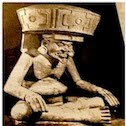 |
| A Strange 1987 Copyright |
 |
| A Correct Dover Edition N-34 BR |
* * * * * * * * * *
Apparently, the Explicativo (book) was created and explained by a person who knew what the iconography was supposed to mean. [The whole reference for the book will be below for this Page N-34-BR #3o. [Tercero] La Señora 2 Caña (Reed) - Quetzal de Jade.
 |
| Having the same red circle and blue [hand] center as Seven Macaw and his [finger crest] and turquoise blute teeth |
To call the bird "Quetzal" might be correct, but the red/blue ring above his head is indicative of a nebula in the Constellation Compass, near the South Pole. The "Hand of God," so-named by NASA, has the same circle of red stars above the hand has the "Quetzal" with the Blue skirted Spinner Lady. This may indicate that the Lady is not only Seven Macaw, but also the "Hand of God" as a different orientation of the constellation called the Summer Triangle, having two more names: the Northern Cross and Cygnus, the Swan).
It was called the "Hand of God" in Maya and was not only in the Nuttall Codex and in various other codices. It also is carved on a Persian monument that may be located in Rome, Italy since the author G. Sesti of the book, The Glorious Constellations lived there, and not in Persia. Since he did not identify where the monument was located, it is a 'sometimes' indication that the source is where the author lived.
Erasmus and Thomas More also knew about the "Hand of God" through a painter named Holbein who painted a family portrait of Thomas More as a result of a referral from Erasmus.
Charlemagne, back a few centuries also was aware of the "Hand of God" nebula.. Charlemagne decided when the "Hand of God" came together with a new branch of the Milky Way. He felt it was just a longer version of the familiar one that circled the world once upon a time only at the Equator it was 360 degrees as a perfect circle for a year of 360 days.
Napoleon was yet another Emperor in Europe that used the Hand of God as his staff of authority. It was just the same as the multiple Maya staffs used to indicate authority in the Yucatán.
Why did the Graz version scratch over the beak of the "Quetzal"? Was it because the "Quetzal" was just Seven Macaw with a different orientation [or sky view] to the world? It does include the great red circle of stars around the finger of the Hand of God. H.m..m.m..
A long time ago, my dentist was telling me about his vacation to New Zealand. On the way back, his wife was looking our of the window of the plane and mentioned that Orion was up-side down. When he queried "why"? She told him that all stars south of the Equator are shifted to an up-side down (or at leasst a 90 degree shift from the northern view.
My research seems to include such statements, because when I looked in up on sky charts in Terrence Dickenson's (1999, ) Nightwatch: Charlemagne was correct. The reason was that when the world shifted, the Milky Way actually became a front and a back branch still connected at both ends by its original circular position, once spanning our Equator. But our tilted spin changed the 360 degree circle to a 365.25 oval and that stretched the ends away from our comfortable view of the stars around us.
It seems that now with our 365.25 day/degree year, created by a shift of 47 degrees to the southeast. According to the Popol Vuh, the Earth was 'sort of" buried in the stars of a single spiral of our galaxy during the beginning of their time schedule. It was only half-a-sun that was seen in those days.
 |
| These two views of our Galaxy only points to our Sun. Our seven Planets, which includes Earth are insignificant in the Galaxtic |
This gave our world a new view of the Milky Way. Our view is now that of an upper register (for summer) and a lower register (for winter). Our North Star is only exact North when the Earth shifts from the Tropic of Cancer to the Equator a span of 23.5 degrees and then continues on to the Tropic of Capricorn near Peru at the southern 23.5 degrees.
 |
| With North straight up in the center, it was not necessary to include |
--------------------------------------
Anders, Ferdinand (Viena) ; Janssen, Maarten (Leuden); Reyes-García, Luis, (México);
(Comisión Técnica Investigadorz, (1992, 163) Crónica Mixteca: El rey 8 Venado, Garra de Jaguar, y la dinastía de Teozacualco-Zoachila; Libro explicativo del llamado Códice Zouche-Nuttal, Ms. 3967l British Museum, Londres; Introducción y explícación; Ferdinand Anders / Maarten Janssen, / Luis Reyes-García, / Gabino Aurora Pérez-Jiménez; Sociedad Estatal Quinto Centenario (España); Akademische Druck- und Verlagsanstalt (Austria); Fondo de Cultura Económica (México)
Page 163 and in the Nuttall Codex, N-34-RB #3o. La señora 2 Caña (Reed). Quetzal de Jade.
Dickenson,'Terrence (1999) Nightwatch: A Practical Guide to Viewing the Universe. 3rd Edition, Willowdale, Onatario, Canada: Firefly Books.
Sesti, Giuseppe Maria (1991) The Glorious Constellations: History and Mythology, (Translator Karin H. Ford) NewYork / Palermo, Italy: Harry N. Abrams, (Novecento Editrice.)
Dickenson,'Terrence (1999) Nightwatch: A Practical Guide to Viewing the Universe. 3rd Edition, Willowdale, Onatario, Canada: Firefly Books.
Sesti, Giuseppe Maria (1991) The Glorious Constellations: History and Mythology, (Translator Karin H. Ford) NewYork / Palermo, Italy: Harry N. Abrams, (Novecento Editrice.)


